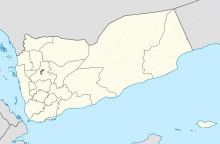Weapons bombs with syths Start date March 20, 2015 Location Sana'a, Yemen | Non-fatal injuries 351 Number of deaths 142 Locations Sana'a, Al-Manar, San‘a’ | |
 | ||
Target Houthi Shi'a worshippers Attack type Quadruple suicide bombing Perpetrators Islamic State of Iraq and the Levant (claimed responsibility) Similar Curtis Culwell Center att, 2015 Beirut bombings, 2015 Suruç bombing, 2015 Saint‑Quentin‑Fallavier attack, 2014 Rada' bombings | ||
The 2015 Sana'a mosque bombings were four suicide attacks on 20 March 2015 in Sana'a, Yemen.
Contents
The attack
The al-Badr and al-Hashoosh mosques came under suicide attack during midday prayers. The blasts killed 142 people and wounded more than 351, making it the deadliest terrorist attack in Yemen's history. One suicide bomber blew up outside the gate of al-Badr mosque when he was caught by militia guards, and the second detonated his device among fleeing people inside the mosque. Another pair of bombers blew up at Al-Hashoosh mosque.
The targeted mosques are linked to the Houthis, a group of the Zaidiyyah sect of Shia Islam. The Houthis deposed the Yemeni government earlier in 2015 after they took control of Sana'a the previous year.
Responsibility
The Islamic State of Iraq and the Levant (ISIL) Yemen branch claimed responsibility for the attack. In a recording released by the group, they stated: "IS soldiers will not rest until they stop the Safawi [Iranian] operation in Yemen.”
According to Bruce Riedel of the Brookings Institution, the bombings were more likely carried out by al-Qaeda in the Arabian Peninsula (AQAP). AQAP denied this, citing instructions from Ayman al-Zawahiri to not attack mosques or markets. If ISIL was responsible, these would be the first attacks it has carried out in Yemen.
Reactions
The U.S. Department of State called for a stop to any military actions, to be followed by a diplomatic solution. Ban Ki-moon, the United Nations Secretary General, demanded that all sides "immediately cease all hostile actions and exercise maximum restraint."
On 23 March, an Iranian Airbus 310 of Mahan Air loaded with 13-ton package of humanitarian aids as well as aid workers of Iranian Red Crescent landed at Sanaa. On its departure from Yemen, 52 wounded people of the bombings were transferred to Tehran to receive treatment. Iran's deputy ambassador Rasai Ebadi said more aid would come soon.
